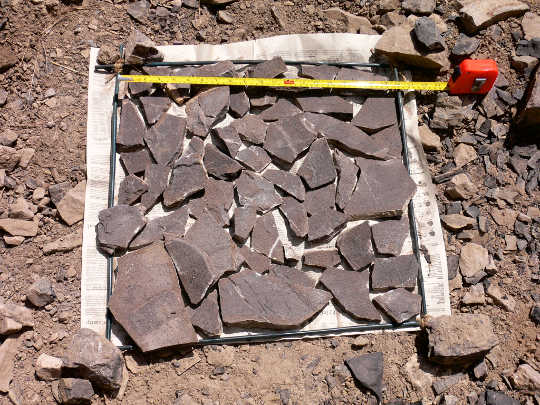
Experts say the results of a study of ancient zooplankton fossils offer a warning about mass extinction events: There’s a tipping point, at which dramatic declines in populations begin.
The researchers studied nearly 22,000 fossils and found that ancient plankton communities began changing in important ways as much as 400,000 years before massive die-offs ensued during the first of Earth’s five great extinctions.
The research, published in the Early Edition of the Proceedings of the National Academy of Sciences, focused on large zooplankton called graptolites. It suggests that the effects of environmental degradation can be subtle until they reach a point of no return.
“In looking at these organisms, what we saw was a disruption of community structures—the way in which the plankton were organized in the water column. Communities came to be less complex and dominated by fewer species well before the massive extinction itself,” says coauthor H. David Sheets, professor of physics at Canisius College and associate research professor at the University at Buffalo.
“I think we need to be quite concerned about where our current ocean communities may be headed or we may find ourselves at the tail end of a similar event—a sixth mass extinction, living in a very different world than we would like.”
This turmoil, occurring in a time of ancient climate change, could hold lessons for the modern world, says coauthor Charles E. Mitchell, professor of geology at the University at Buffalo.
 Samples holding graptolite fossils, collected in bulk from Nevada. (Credit: Charles E. Mitchell)The shifts took place at the end of the Ordovician Period some 450 million years ago as the planet transitioned from a warm era into a cooler one, leading eventually to glaciation and lower sea levels.
Samples holding graptolite fossils, collected in bulk from Nevada. (Credit: Charles E. Mitchell)The shifts took place at the end of the Ordovician Period some 450 million years ago as the planet transitioned from a warm era into a cooler one, leading eventually to glaciation and lower sea levels.
“Our research suggests that ecosystems often respond in stepwise and mostly predictable ways to changes in the physical environment—until they can’t. Then we see much larger, more abrupt, and ecologically disruptive changes,” Mitchell says. “The nature of such tipping point effects are hard to foresee and, at least in this case, they led to large and permanent changes in the composition of the oceans’ living communities.
“I think we need to be quite concerned about where our current ocean communities may be headed or we may find ourselves at the tail end of a similar event—a sixth mass extinction, living in a very different world than we would like.”
Long slide toward oblivion
In considering mass extinction, there is perhaps the temptation to think of such events as rapid and sudden: At one moment in history, various species are present, and the next they are not.
This might be the conclusion you’d draw if you examined only whether different species of graptolites were present in the fossil record in the years immediately preceding and following the Ordovician extinction.
“If you just looked at whether they were present—if they were there or not—they were there right up to the brink of the extinction,” Sheets says. “But in reality, these communities had begun declining quite a while before species started going extinct.”
The research teased out these details by using 21,946 fossil specimens from areas of Nevada in the US and the Yukon in Canada that were once ancient sea beds to paint a picture of graptolite evolution.
The analysis found that as ocean circulation patterns began to shift hundreds of thousands of years before the Ordovician extinction, graptolite communities that previously included a rich array of both shallow- and deep-sea species began to lose their diversity and complexity.
Deep-water graptolites became progressively rarer in comparison to their shallow-water counterparts, which came to dominate the ocean.
“There was less variety of organisms, and the rare organisms got rarer,” Sheets says. “In the aftermath of a forest fire in the modern world, you might find that there are fewer organisms left—that the ecosystem just doesn’t have the same structure and richness as before. That’s the same pattern we see here.”
The dwindling deep-sea graptolites were species that specialized in obtaining nutrients from low-oxygen zones of the ocean. A decrease in the availability of such habitats may have sparked the creatures’ decline, Sheets and Mitchell say.
“Temperature changes drive deep ocean circulations, and we think the deep-water graptolites lost their habitats as the climate changed,” Sheets says. “As the nature of the oceans shifted, their way of life went away.”
The US National Science Foundation, Natural Sciences and Engineering Research Council of Canada, and Czech Academy of Sciences supported the work. The study was a partnership between Canisius, the University at Buffalo, St. Francis Xavier University, Dalhousie University and the Czech Academy of Sciences.
Source: University at Buffalo
Related Books
at

Thanks for visiting InnerSelf.com, where there are 20,000+ life-altering articles promoting "New Attitudes and New Possibilities." All articles are translated into 30+ languages. Subscribe to InnerSelf Magazine, published weekly, and Marie T Russell's Daily Inspiration. InnerSelf Magazine has been published since 1985.

Thanks for visiting InnerSelf.com, where there are 20,000+ life-altering articles promoting "New Attitudes and New Possibilities." All articles are translated into 30+ languages. Subscribe to InnerSelf Magazine, published weekly, and Marie T Russell's Daily Inspiration. InnerSelf Magazine has been published since 1985.





















